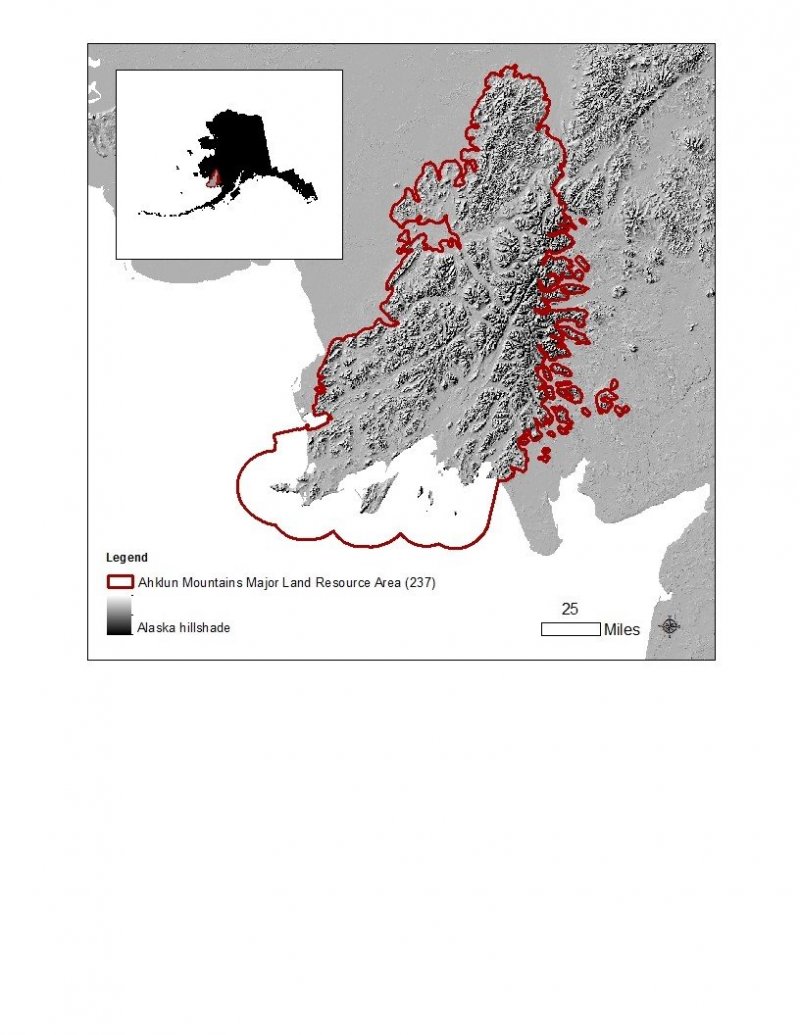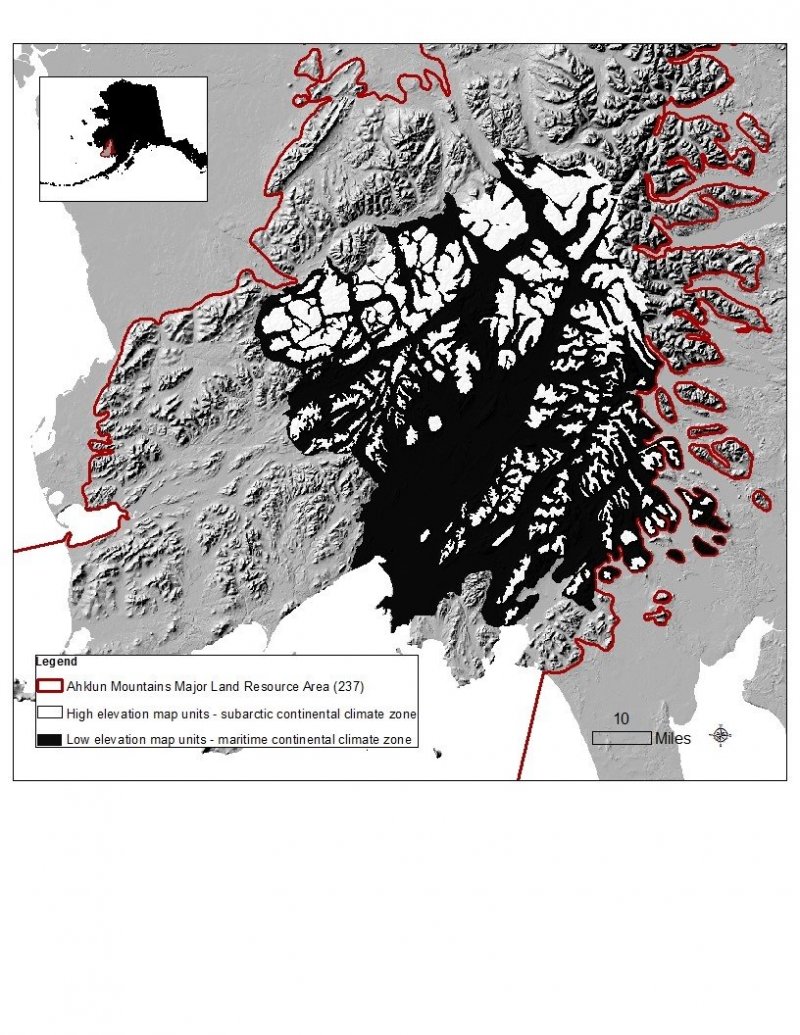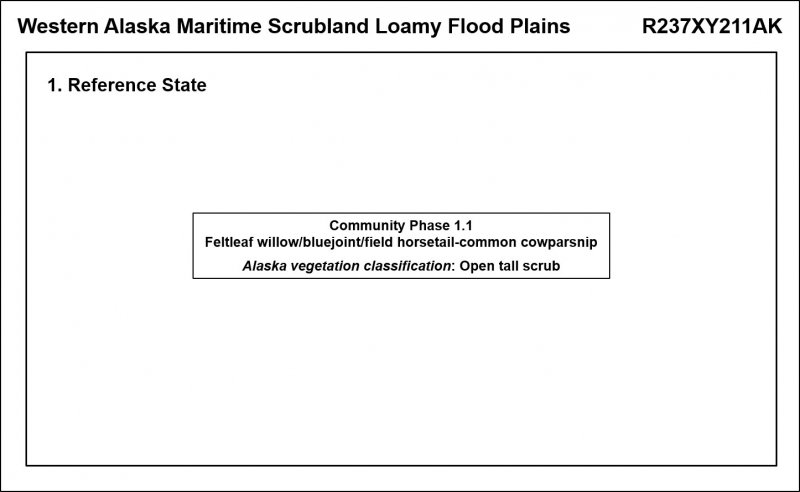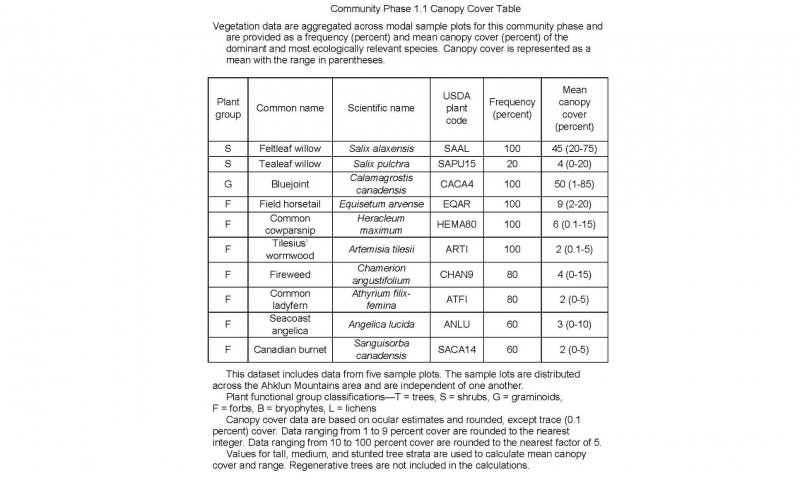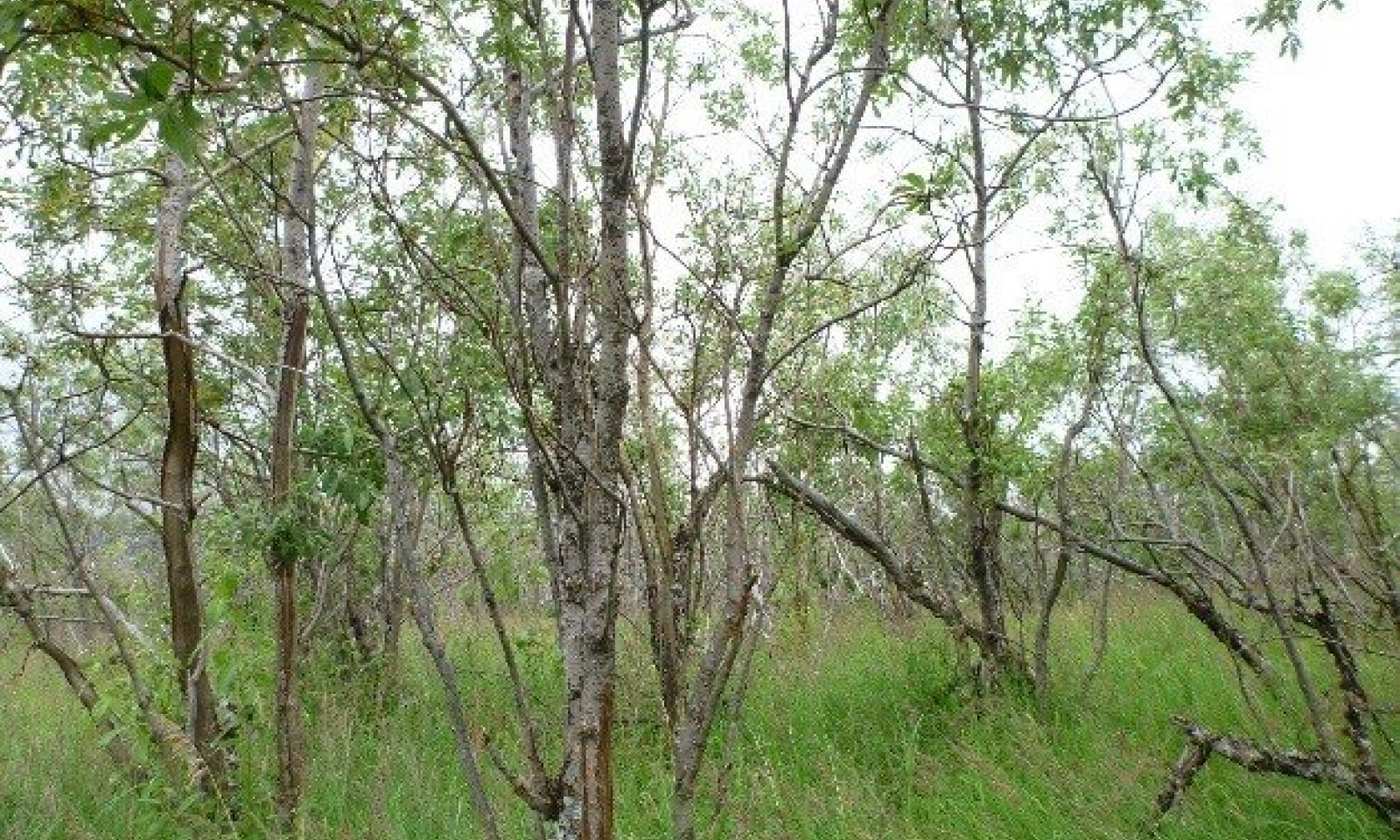

Natural Resources
Conservation Service
Ecological site R237XY211AK
Western Alaska Maritime Scrubland Loamy Flood Plains
Last updated: 7/23/2020
Accessed: 12/22/2025
General information
Provisional. A provisional ecological site description has undergone quality control and quality assurance review. It contains a working state and transition model and enough information to identify the ecological site.
MLRA notes
Major Land Resource Area (MLRA): 237X–Ahklun Mountains
The Ahklun Mountains Major Land Resource Area (MLRA 237) is in western Alaska (fig. 1). This MLRA covers approximately 14,555 square miles, and it includes the mountains, hills, and valleys of the Kilbuck Mountains in the north and the Ahklun Mountains in the south. Except for the Kilbuck Mountains and the highest ridges of the Ahklun Mountains, the MLRA was extensively glaciated during the Pleistocene (Kautz et al., 2004). Today, a few small glaciers persist in mountainous cirques (Gallant et al., 1995). The present-day landscape and landforms reflect this glacial history; glacial moraines and glacial drift cover much of the area (USDA-NRCS, 2006). The landscape of the MLRA is primarily defined by low, steep, rugged mountains cut by narrow-to-broad valleys. Flood plains and terraces of varying sizes are common at the lower elevations in the valley bottoms. Glacially carved valleys host many lakes. Togiak Lake is one of the largest lakes in the region. It is 13 miles long and about 9,500 acres in size. Major rivers include the Goodnews, Togiak, Kanektok, Osviak, Eek, and Arolik Rivers. Where the Goodnews and Togiak Rivers reach the coast, the nearly level to rolling deltas support numerous small lakes.
This MLRA has two distinct climatic zones: subarctic continental and maritime continental (fig. 2). The high-elevation areas are in the subarctic continental zone. The mean annual precipitation is more than 75 inches, and the mean annual air temperature is below about 27 degrees F (-3 degrees C) in extreme locations. The warmer, drier areas at the lower elevations are in the maritime continental zone. The mean annual precipitation is 20 to 50 inches, and the mean annual air temperature is about 30 to 32 degrees F (-0.2 to 1.2 degrees C) (PRISM). This climatic zone is influenced by both maritime and continental factors. The temperatures in summer are moderated by the open waters of the Bering Sea, and the temperatures in winter are more continental due to the presence of ice in the sea (Western Regional Climate Center, 2017). The seasonal ice reaches its southernmost extent off the coast of Alaska in Bristol Bay (Alaska Climate Research Center, 2017). The western coast of Alaska is also influenced by high winds from strong storms and airmasses in the Interior Region of Alaska (Hartmann, 2002).
The Ahklun Mountains MLRA is principally undeveloped wilderness. Federally managed lands include the Togiak and Alaska Maritime National Wildlife Refuges. The MLRA is sparsely populated, but it has several communities, including Togiak, Manokotak, Twin Hills, and Goodnews Bay. Togiak is the largest village. It has a population of approximately 855, most of which are Yup’ik Alaska Natives (U.S. Census Bureau, 2016). Major land uses include subsistence activities (fishing, hunting, and gathering) and wildlife recreation (USDA-NRCS, 2006; Kautz et al., 2004).
Ecological site concept
Ecological site R237XY211AK is on mid flood plains. The reference state has one community phase. No alternate states are recorded for this ecological site.
The reference plant community is open tall scrubland (Viereck et al., 1992). It consists of willows (Salix spp.) and an understory of hydrophilic, shade-tolerant forbs and graminoids. Bluejoint (Calamagrostis canadensis) and myriad forbs such as field horsetail (Equisetum arvense), common cowparsnip (Heracleum maximum), and fireweed (Chamerion angustifolium) are in the understory.
Associated sites
| R237XY210AK |
Western Alaska Maritime Scrubland Gravelly Flood Plains Ecological site R237XY211AK is on mid flood plains throughout the Ahklun Mountains area. Other ecological sites on flood plains in this area are distinguished by differences in elevation, disturbance, landform, location, associated soils, and type and amount of plants. These sites include R237XY210AK, R237XY212AK, and F237XY216AK. Site R237XY226AK is in depressions of flood plains. Ecotonal plant communities that have characteristics from more than one ecological site are in areas where these sites abut. |
|---|---|
| F237XY216AK |
Boreal Woodland Loamy Flood Plains Ecological site R237XY211AK is on mid flood plains throughout the Ahklun Mountains area. Other ecological sites on flood plains in this area are distinguished by differences in elevation, disturbance, landform, location, associated soils, and type and amount of plants. These sites include R237XY210AK, R237XY212AK, and F237XY216AK. Site R237XY226AK is in depressions of flood plains. Ecotonal plant communities that have characteristics from more than one ecological site are in areas where these sites abut. |
| R237XY212AK |
Western Alaska Maritime Scrubland Silty Flood Plains Ecological site R237XY211AK is on mid flood plains throughout the Ahklun Mountains area. Other ecological sites on flood plains in this area are distinguished by differences in elevation, disturbance, landform, location, associated soils, and type and amount of plants. These sites include R237XY210AK, R237XY212AK, and F237XY216AK. Site R237XY226AK is in depressions of flood plains. Ecotonal plant communities that have characteristics from more than one ecological site are in areas where these sites abut. |
| R237XY226AK |
Western Alaska Maritime Grassland Peat Flood Plains, Depression Ecological site R237XY211AK is on mid flood plains throughout the Ahklun Mountains area. Other ecological sites on flood plains in this area are distinguished by differences in elevation, disturbance, landform, location, associated soils, and type and amount of plants. These sites include R237XY210AK, R237XY212AK, and F237XY216AK. Site R237XY226AK is in depressions of flood plains. Ecotonal plant communities that have characteristics from more than one ecological site are in areas where these sites abut. |
Similar sites
| R237XY210AK |
Western Alaska Maritime Scrubland Gravelly Flood Plains No other ecological sites in the survey area support a similar feltleaf willow community; however, several other ecological sites are on flood plains. These sites are subject to flooding and support a variety of hydrophilic plants. Differences in soil, landform, disturbance regime, and location result in distinct vegetative communities. Site R237XY210AK is on low flood plains that are subject to a different frequency and duration of flooding and are associated with different soils. Because of these differences, unique ecological sites are needed. |
|---|---|
| R237XY212AK |
Western Alaska Maritime Scrubland Silty Flood Plains No other ecological sites in the survey area support a similar feltleaf willow community; however, several other ecological sites are on flood plains. These sites are subject to flooding and support a variety of hydrophilic plants. Differences in soil, landform, disturbance regime, and location result in distinct vegetative communities. Site R237XY212AK is in wetter areas that support more hydrophilic plant species. Because of these differences, unique ecological sites are needed. |
| F237XY216AK |
Boreal Woodland Loamy Flood Plains No other ecological sites in the survey area support a similar feltleaf willow community; however, several other ecological sites are on flood plains. These sites are subject to flooding and support a variety of hydrophilic plants. Differences in soil, landform, disturbance regime, and location result in distinct vegetative communities. Site F237XY216AK is forested and is on mid to high flood plains along the Izavieknik River. Because of these differences, unique ecological sites are needed. |
Table 1. Dominant plant species
| Tree |
Not specified |
|---|---|
| Shrub |
(1) Salix alaxensis |
| Herbaceous |
(1) Calamagrostis canadensis |
Click on box and path labels to scroll to the respective text.
